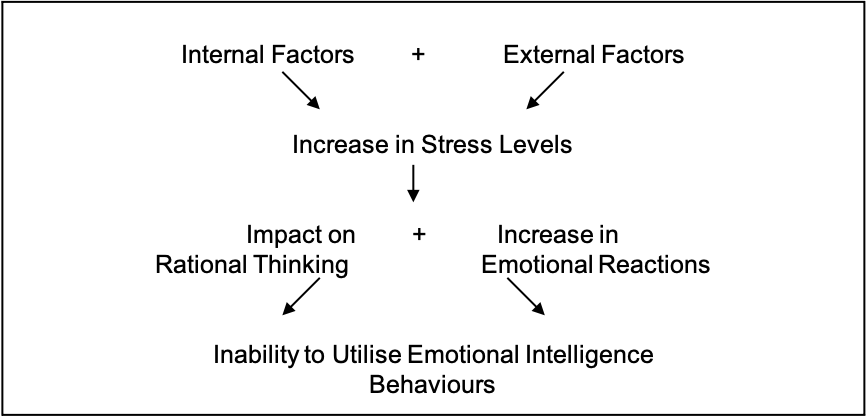In these incredibly challenging times, it is easy to become stressed and not notice the affect it is having on you, and those around you. It can cause friction both at home and in your work life, so it really should be tackled. It is especially important, if you are in a management or leadership role, to be able to recognise the symptoms of stress in others and deal with the organisational challenges that could be creating stressful situations for colleagues. Perhaps we should look at what stress is and how it can affect people both physically and emotionally before we look at ways of dealing with it.
What is Stress?
Stress affects everyone. It is a necessary and essential part of our lives, an inevitable result of the interaction between us and our environment and to keep us on our toes in order to survive.
The stress response evolved to enable humans to deal with life-threatening dangers, for example, being confronted by a predator such as a sabre-toothed tiger. Activation of this stress response very quickly prepared the body for physical activity; to stand and fight or turn tail and flee (fight/flight-response). Today, in our advanced technological and computerised world, we live in a ‘convenience’ society. Because of the structure of this society, most of our time is spent in complex and often confusing social interaction. This has become extremely complicated because of the effects of urbanisation and the types of society we have created since our cave-dwelling days. Competition is more evident today than ever before: competing for jobs, striving for career promotion. Sadly, in today’s society we tend to get caught up in the ‘rat race’. We become pulled along in a tide of emotional and social demands and at the same time we have to find work and earn a living or face redundancy and unemployment. Our body may become prepared for a fight if we see the boss as a sabre-toothed tiger, lurking behind a desk, threatening our self-esteem, career prospects or job security, but we cannot leap into physical conflict. Instead we fume inside, hit the bottle, or vent our anger on others. Activation of our stress response, without physical activity, which is meant to follow, can be potentially harmful to health. We are dealing with today’s social demands by using a stress response designed to allow our ancestors to deal with physical dangers. Today, the threat of losing a job, the struggle to find employment, job stress, marital and family disharmony, loneliness and financial problems are some situations that can eat away at us over a long period.
So, it is not stress in itself that is the problem. The increased intensity, frequency, pattern, and variety of demands placed on the body activates the stress response in such a way that may ultimately become detrimental to our health.
Stress can therefore be defined as a state we experience when there is:
A mismatch between perceived demands and perceived ability to cope. It is the balance between how we view demands and how we think we can cope with those demands that determine whether we feel stressed.
Symptoms of stress
Physical
- Aware of heart beating, palpitations
- Breathlessness, lump in the throat, rapid, shallow breathing
- Dry mouth, ‘butterflies’ in the stomach, indigestion, nausea
- Diarrhoea, constipation, flatulence
- General muscle tenseness
- Clenched fists, hunched shoulders, muscle aches, cramps and pains
- Restless, hyperactivity, nail biting, finger drumming, foot tapping, hands shaking
- Tired, fatigued, lethargic, exhausted, sleep difficulties, feeling faint, headaches, frequent colds
- Sweaty palms, hot flushed feelings
- Cold hands/feet
- Frequent desire to urinate
- Overeating, loss of appetite, increased smoking
Increased alcohol consumption, loss of interest in intimacy
Mental
- Distressed, worried, upset, tearful, deflated, feelings of helplessness and hopelessness, hysterical, withdrawn, feeling unable to cope, anxious, depressed
- Impatient, easily irritated and aggravated, angry, hostile, aggressive
- Frustrated, bored, inadequate, guilty, rejected, insecure, vulnerable
- Loss of interest in self appearance, health, diet, sex, low self esteem and loss of interest in others
- Doing too many things at once, rushed
- Failing to finish tasks before moving onto the next
- Difficulty in thinking clearly, concentrating, making decisions, forgetful, lack of creativity, irrational, procrastinating
- Having so much to do and not knowing where to start so ending up doing nothing
- Hypercritical, inflexible, unreasonable, over-reactive, non-productive
This list is not exhaustive and some of the symptoms, particularly the physical ones, can be the result of problems other than stress.


Sources of stress in organisations
When a person’s role in an organisation is clearly defined and understood, and when expectations placed upon the individual are also clear and non-conflicting, stress can be kept to a minimum. It is the responsibility of all managers to ensure their organisation is best equipped to minimise stress at work. Making sure the factors described below are dealt with is critical if stress is to be combatted.
Role Ambiguity
Role ambiguity arises when an individual does not have a clear picture about his/her work objectives, colleagues’ expectations of him/her and the scope and responsibilities of the job. If an individual does not know where he/she fits into the organisation and is unsure of any rewards no matter how well they perform, it can lead to depressed mood, low self esteem, general dissatisfaction and low motivation to work.
Role Conflict
Role conflict exists when an individual is torn by conflicting job demands or by doing things he or she does not really want to do, or things which the individual does not believe, are part of the job. Individuals may often feel themselves torn between two groups of people who demand different types of behaviour or who believe the job entails different functions. They may also perceive a conflict between their values and beliefs, and those of the team or organisation.
Responsibility
Responsibility has been found to be another organisational role stress agent. There are basically two types of responsibility: responsibility for people and responsibility for things, such as budgets, equipment and buildings. Responsibility for people has been found to be particularly stressful. Being responsible for people usually requires spending more time interacting with others, dealing with conflict and generally developing relationships with people. Supportive relationships with managers, peers and subordinates at work are less likely to create interpersonal pressures and will directly reduce levels of perceived job stress.
Participation at Work
As early as the 1940s, researchers began reporting that workers who were allowed more participation in decision-making produced more and had higher job satisfaction. They also found that non-participation at work was a significant predictor of job-related stress leading to absenteeism, depression, low self-esteem and plans to leave. Participation in the decision-making process on the part of the individual may help increase feelings of investment in the organisation’s success, create a sense of belonging and improve the communication channels. This is vital for the well being of the work force.
Managing stress
Preventing Stress
- Developing a support system
- Be clear about values
- Set clear objectives
- Develop assertiveness skills
- Develop interpersonal skills
- Develop Time Management skills
- Maintain physical fitness
- Check your diet
Recovery Periods
Stress can be managed more effectively, and we can even thrive on stress, if we manage our time so that recovery periods are built into our everyday life. These are deliberately planned, fixed points that will help us recover our balance and we can look forward to them when the going gets tough.
Fixed recovery periods could be:
- On a daily basis – a proper lunch break
- Weekly – yoga, meditation classes, relaxing with friends
- On a longer-term basis – a holiday, a complete break from the usual routine
Stability Zones
Stability Zones are the key elements in your life that you rely on to make you feel good. Knowing what makes up your stability zones allows you to have a reliable, constant source of good feelings making it easier to withstand stress. They seem like havens of rest and sanity in an otherwise uncontrollable world.
- Places
- Objects
- People
- Organisations
- Activities
- Values, beliefs, philosophy
- Where you feel at home, belong, have roots
- Which give you a good feeling
- You can rely on
- To which you belong
- Such as hobbies, sport
- Your personal value/belief system, religious philosophy
Managing stress
- Keep things in perspective
- Positive self talk
- Take a few deep breaths
- Exercise
- Self contemplation/meditation
- Work off stress
- Talk to someone you trust
- Learn to accept what you cannot change
- Avoid self medication
- Get enough sleep and rest
- Do something for others
- Take time out to ‘play’
- Take one thing at a time
- Agree with someone
- Manage your time better
- Plan ahead
- Stop when you are not well
- Take up a hobby
- Believe the answer lies within you
- Eat well and exercise
- Do not put off relaxing
- Do not be afraid to say no
- Know when you are tired
- Learn how to delegate
- Be realistic about perfection

Stress and health
The stress response involves all body functions so too much distress can lead to exhaustion, a variety of health problems and can even be fatal. It has been estimated that at least 75% of illness reported to GPs is stress related. Some stress related disorders and diseases are listed below:
Cardiovascular System
- Coronary heart disease (angina/heart attacks)
- Hypertension (high blood pressure)
- Strokes
Muscular
- Headaches
- Cramps
- Muscle spasm
- Back pain
- Neck pain
Digestive System
- Indigestion
- Nausea
- Heartburn
- Stomach and duodenal ulcers
- Colitis
- Irritable bowl syndrome
- Diarrhoea
- Constipation
Others
- Diabetes
- Cancer
- Rheumatoid artritis
- Allergies
- Asthma
- Sleep disorders
- Sexual disorders
- Skin disorders
Behavioural
- Overeating – obesity
- Loss of appetite – anorexia
- Increased caffine
- Increased alcohol
- Drug abuse
Emotional
- Anxiety, including fears, phobias and obsessions
- Depression
Why people react positively or negatively
The way people react to stressful situations can be analysed at three levels. At each level the reaction can be positive, accessing what is referred to as the ‘bright side’, or negative, accessing their ‘dark side’, depending on whether they were in a positive or negative frame of mind or emotional state. The three levels are:
- The inner ‘world’ – thoughts and feeling, including emotional state and degree of self-control
- The outer ‘world’ – the way one projects oneself in the outside world
- The interactive ‘world’ – the way one interacts with the team, very often resulting in the culture of the team
The inner world
Three key interrelated mental processes determine the inner world:
- Competence
- Commitment
- Control
Competence
This requires a thorough knowledge of the job or task and the ability to develop winning strategies and to make the best use of one’s strengths.
Commitment
This requires a positive attitude to the task in hand, an enjoyment and involvement
Control
This requires an ability to feel in control of the situation.
When these three factors are positive, the individual feels a sense of wellbeing, in control of both themselves and the situation.
Positive outcome of the inner ‘world’
- Positive outlook
- Enjoying journey
- Sense of well-being
Negative outcome of the inner ‘world’
- Negative outlook
- Wanting to get to destination
- Lack of well-being
The outer world
The outer world determines whether one projects oneself externally in a positive or negative way and affects the processes and behaviour used in a leadership role.
Three key interrelated processes determine the outer world:
- Energy
- Flexibility
- Control
Energy
Here there is a focused, consistent and energetic approach with optimal stress levels.
Flexibility
Here there is an ability to adapt to the situation and to be willing to listen to others’ viewpoint when making decisions.
Control
This requires an ability to keep emotions under control, to show vulnerability at the appropriate time
Positive outcome of the outer ‘world’
- Focused
- Consistent
- Uses emotionally intelligent behaviours
- Show vulnerability
Negative outcome of the outer ‘world’
- Unfocused
- Inconsistent
- Lack of emotional intelligence
- Hides vulnerability
The interactive world
The interactive world determines whether one is able to share leadership with the team and give them involvement and responsibility.
The key interrelated processes determine the interactive world:
- Belief
- Control
- Accountability
Belief
The requires one to be able to inspire belief within the team, so that they believe in their capability to perform
Control
This requires one to ensure that the team are in control of the situation and that conflict is professionally managed
Accountability
This requires one to be able to share accountability and responsibility with the team.
Positive outcome of the interactive ‘world’
- Optimum stress
- Manages conflict
- Team aligned with leader
- Shared leadership
Negative outcome of the interactive‘world’
- High stress
- Unresolved conflict
- Team alienated from leader
- Autocratic leadership
Stress, performance and emotional intelligence
These three are inextricably linked. When one is not optimal it will have an immediate reaction on the other two.

So now we know more about what stress is and how it can affect people, lets start by measuring your current emotional resilience level. Please complete the short questionnaire on the next page. Being very honest with your answers will pay dividends when you look to tackle the areas causing you stress.
Feedback
A particularly good way to tackle the areas that cause you stress is to seek specific feedback from others who are in a particular situation with you. Once you have received the feedback go to work, to develop a plan of activity to minimise the causes of stress.
A great friend of mine once said, ‘If five people say you act like a horse, go and buy a saddle.’ Which was his way of saying take the feedback as it is intended. If you ask for honest feedback you might not always like the answers, but if you are serious about building your emotional resilience and minimising stress you need to listen to the feedback and act upon it. Not all feedback is going to be negative so do listen to the positive feedback too and do more of the aspects of the positive feedback recognised as really helpful in the situation they are sharing with you. Making sure you understand he good work you do is as important as working on the other skills and behaviours that need some development.
Dealing with feedback
In order to deal with feedback, one has to know oneself:
· Is a negative comment true?
If so, agree with it, and ask for ideas on how to improve that aspect
· Is a positive comment true?
If so, thank the giver!
· Is a negative comment untrue?
If so, ask for the person to explain why they think that about you – be curious!
· Is a positive comment untrue?
If so, ask why they think that – you may get an interesting explanation that increases your knowledge of yourself
· If you do not understand the feedback because it is vague, or just unhelpful, ask for an explanation.
I am confused by your comment, what do you mean?
I do not know what you are trying to say, can you explain in more detail?
You can actively seek feedback in order to develop yourself, by asking the questions:
- What should I stop doing?
- What should I start doing?
- What should I continue doing?
Should you recognise stress in others you could offer to give then feedback.
How to give helpful feedback
- Describe what you saw happen – the behaviour, not your interpretation of it.
- Describe how you reacted to it – why it was good, or why it was a problem.
- Own your feedback – use the words ‘I think…….’
- Describe some alternatives
How to receive feedback
It is equally difficult to receive feedback. Here are some tips:
- Take a breath
- Write down the information
- Do not explain or try to justify, just ask for examples
- No ‘yes, but’ s, stay open minded
- Show appreciation for the information
Building emotional resilience
Emotional resilience is the ability to perform consistently in a range of situations under pressure and to adapt behaviour appropriately. The ability to balance the needs of the situation and task with the needs and concerns of the individuals involved. The ability to retain focus on a course of action or need for results in the face of personal challenge or criticism.
So how to go about developing emotional resilience:
- develop self-awareness
- seek feedback from people not directly involved in a situation
- do something that ‘scares’ you a little every day – for example, a difficult call
- identify mood / mindset needed for each situation
- know things are never as bad or as good as you think
- think about it, try building a time for daily reflection into your schedule
- try again, we all get better the more we try
- also analyse a ‘failed project’ list the practical lessons learned and focus on what you would do differently next time you are faced with a similar project
- adopt the mindset, ‘there is no failure only feedback’.
- try to spend more time with positive optimistic people who encourage you
- bring clarity to long and short-term goals in order to achieve them
- focus on the positives of what has been learnt
- promote a no blame culture
Building your emotional resilience is going to take time and tenacity. The very best of luck. A useful measurement is to retake the questionnaire in 6 months from now and see how you have developed.













